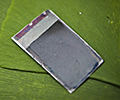The so-called “artificial leaf,” a solar cell being developed by MIT and Harvard scientists to produce low-cost electricity, is now capable of “self healing” the damage that occurs during energy production, clearing  a hurdle to deploying the device in the developing world, the researchers say. When dipped into water, the leaf — which is actually a catalyst-coated wafer of silicon about the size of a playing card — is able to split water into its two components, hydrogen and oxygen, which can then be collected and used as fuel to power a fuel cell. “Surprisingly, some of the catalysts we’ve developed for use in the artificial leaf device actually heal themselves,” Daniel Nocera of Harvard, the leader of the research team, told a meeting of the American Chemical Society. While earlier versions of the device required pure water, the self-healing properties enable users to operate the leaf using impure, bacteria-contaminated water. According to the researchers, the leaf is now able to generate 100 watts of electricity 24 hours a day with just a quart of water.
a hurdle to deploying the device in the developing world, the researchers say. When dipped into water, the leaf — which is actually a catalyst-coated wafer of silicon about the size of a playing card — is able to split water into its two components, hydrogen and oxygen, which can then be collected and used as fuel to power a fuel cell. “Surprisingly, some of the catalysts we’ve developed for use in the artificial leaf device actually heal themselves,” Daniel Nocera of Harvard, the leader of the research team, told a meeting of the American Chemical Society. While earlier versions of the device required pure water, the self-healing properties enable users to operate the leaf using impure, bacteria-contaminated water. According to the researchers, the leaf is now able to generate 100 watts of electricity 24 hours a day with just a quart of water.

Dominick Reuter/MIT
The artificial leaf